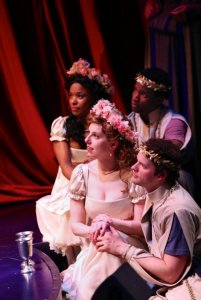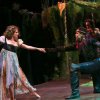Unexpected Magic in Geva's Dream
Hot- Midsummer Night's Dream
- by William Shakespeare
- Geva Theatre Center
- May 8 - June 2, 2013
| Acting |  |
| Costumes |  |
| Sets |  |
| Overall |  |
You expect some magic with A Midsummer Night’s Dream.
Geva Theatre Center, in Rochester, NY, provides just that. Geva’s version of Dream features delightful child fairies and an Oberon (a regal Keith Hamilton Cobb) and Titania (an archCarly Street) so passionate in their rule of the natural world that they change the color of the moon with their moods.
But what you might not expect is that the best magic doesn’t come from a tiny fairy at all. It comes from an actor more than 6 feet tall, dressed in drag, with overpainted lips and pigtails sopreposterously askew that they resemble antennae.
Ron Menzel, as Francis Flute playing the play-within-a-play’s Thisbe, nearly stops the show.
The scene is set up by Bottom (Brian O’Connor) executing an uproarious death scene as Pyramus, Thisbe’s lover. Pyramus uses his sword to assail every limb, then, kneeling, grasps the blade between his thighs so his torso can fall on it. Not satisfied that he has fully killed himself, he starts over again before finally meeting his self-administered demise.
When Thisbe enters, you expect her to echo Pyramus’ death with a funny one of her own. This is, after all, a character who needs a hand – quite literally – from a cranky Peter Quince (Munson Hicks) to reach the appropriate falsetto. Instead, Menzel’s Thisbe acts with such pathos at the discovery of her dead beloved, that she brings the house to the brink of tears before swiftly dispatching herself.
Hippolyta is moved to a standing ovation by the display, and the audience nearly is, too.
A quick recap for those who’ve never stumbled upon a production of this beloved play: the duke of Athens is about to get married and a band of fools is preparing a play for the festivities. A nobleman asks the duke to rule on whether his daughter should marry the man her father has chosen for her rather than the man she loves. The daughter and her lover escape to the forest to avoid the duke’s harsh ruling, followed by the other young man and his former girlfriend. Everyone falls prey to fairy magic and a lovers’ quarrel between fairy royalty that first adds to the mess and ultimately untangles it.
Emily Kunkel as Helena steals almost every scene in which she appears, channeling the gawky comic timing of Carol Burnett while bemoaning her difficulties in gaining the man she loves. When the suddenly bewitched Lysander (a lusty Sheldon Best) leaves his girlfriend and says nature has shown him Helena’s heart, Kunkel recoils and clutches her shawl to her cleavage lest he see more than her heart. When the object of her frustrated affections, Demetrius (Ian Holcomb) is likewise entranced, she does a little happy dance.
Co-directors Mark Cuddy and Skip Greer have upped the play’s humor with excellent choices of staging and action. They have Puck (George Abud) enter and exit by a different exotic method each time, popping in and out of a variety of trapdoors, scaling the Athenian forest like a jungle gym and peering out of a hidden window on level with the balcony.
One of the best laughs comes when Hermia (Kaliswa Brewer) signals she’s about to do some bodily harm to Helena with the school-girl equivalent of throwing down a gauntlet: she removes her earrings and tosses them angrily aside.
Carrying out the theme of discovery and surprise is the set, designed by Jo Winiarksi and lit beautifully by Ann G. Wrightson. At first the set appears stark: just a slightly raised circle in the floor and curtains of blue, red and white in a toga-like drape. But when the formal city of Athens gives way to the surrounding woods, you can almost smell the moss. Walls of tree trunks line the stage, and tiny fairy lights in the bark sparkle. Nothing is ever quite what it seems in this setting, with fairies appearing from nowhere.
Costuming (costume designer Pamela Scofield and wig designer Bekah Carey) doesn’t turn out quite as well. From a distance, the animal-print body suits worn under ornate embellishments read as muddy and the bright green wigs draw too much visual attention.
More effective is the leather ensemble evoking the prenuptial archery activities of Hippoltya, and the satyr outfit worn by Puck, which includes a wig of long dreadlocks.
This Dream takes a risk casting (Paul Forquet, Elissa Myers Casting) local children as young as seven to play alongside Equity actors who’ve walked the boards on Broadway, off-Broadway and at regional theaters around the country. But the kids do more than keep up, particularly seventeen-year-old Rebecca Rand, a graceful and angel-voiced First Fairy who goes toe-to-toe with Puck. She leads the other child actors in singing an eerie composition by John Zeretzke with complex harmonies.
Geva's production of Dream, ending it 40th season, strikes similarly pretty harmonies.
Discuss this review or play in our forums
Reviews on this site are subject to this required disclosure.









